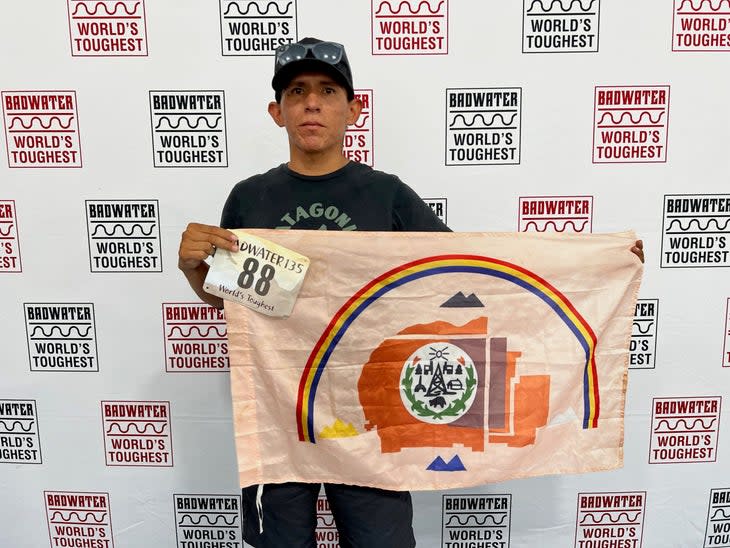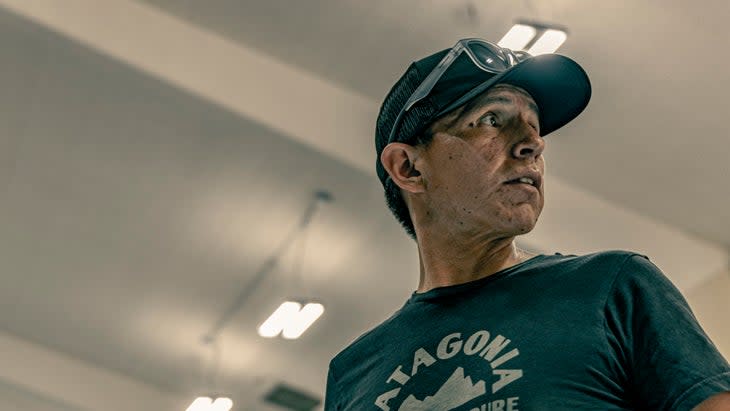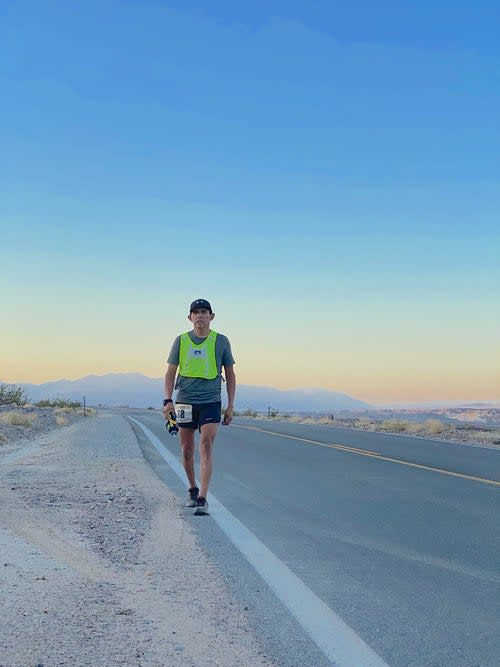Meet the Only Indigenous Ultrarunner To Attempt This Year’s Badwater 135
Trail Runner
Eli Neztsosie, 34, was packing his truck with coolers, supplies, and running gear, for the 45th anniversary of the Badwater 135 Ultramarathon. The night before, he finally slept in a bed, the first time in a month.
He had just returned from Tucson, Arizona, where he'd been heat training - sleeping in random locations in the back seat of his truck. But now, before departing for the Badwater Basin of California's Death Valley, he first had to take care of his livestock.
Neztsosie is a rancher and ultrarunner from the remote Navajo Mountain, Arizona. Surrounded by hundreds of canyons, this is his training ground and home to his sprawling ranch. He lives at Navajo Mountain, the highest elevation in the Navajo Nation, which, according to traditional belief, represents the sacred female's, "Head of the Earth." As a sacred landmark for local tribes, it is believed the mountain can help cure sickness and bring rain. Although hiking and camping around the mountain are permitted, climbing and summiting the peak are prohibited.
As the only Indigenous runner in Badwater's field this year, the race provided Neztsosie with the opportunity to advocate for the sacred lands around his home.
Ranching and ultrarunning run parallel. Both require a deep well of grit and mental fortitude. He attributes both to being raised primarily by men in a rigid ranching environment.
RELATED: Send a Runner: A Run of Acknowledgement
"I grew up in a very old-fashioned Native American ranching lifestyle," said Neztsosie. He ranches the same acres his ancestors did before him, and does so in an old-fashioned way - with horses, not ATVs or dirt bikes. "I see a lot of energy in Mother Nature, in the trees, in the land and water. I feed off that energy every time I’m out there on a run. It's like nature's natural energy."

Geotagging the Sacred
Land exploitation is a big concern for Neztsosie. He takes issue with climbers and runners who geotag their locations around sacred sites on social media. When prominent people do this, they're - likely, unknowingly - exploiting the land.
"They don’t realize it, that they're creating a mass influx of tourists and other people out there to come into these lands," Neztsosie said. "With that comes a lot of pollution and destruction of natural beauty. Even down to people taking pottery. I try my best to tell people, 'Hey, let's not do this. It’s not right. You can come here. But, you know, please leave it the way it is.'"
The principles espoused by Neztsosie mirror those of the Leave No Trace guidelines. These guidelines work to facilitate minimum impact for individuals visiting the outdoors, ensuring that future visitors have a similar experience by leaving rocks, plants, and artifacts as they are.

Indigenous Death Valley
For more than 1,000 years, the Timbisha Shoshone lived in Death Valley, California. For the Timbisha, the land was called Tumpisa, which means "rock paint," and refers to the surplus of red ochre in the valley. Due to the reddish tint of the deep orange to brown stone pigment, they believed it to be the blood of the earth.
Settlers in the 1800s coined the name "Death Valley," while pursuing gold, silver, and borax. The name came from a group of pioneers lost in the area. After a member of the group died, they assumed the rest would follow. Soon after, they were rescued from the valley by two scouts. Once they were safely out of the valley and over the Panamint Range, one of the men turned around and said, "Goodbye, Death Valley."
RELATED: You Cannot Erase Us: Letter From An Indigenous Runner
Soon after, mining operations moved in and obtained legal rights to the water sources in the area. These mining pursuits led to the Timbisha being relocated from their homelands and having their lives entirely altered. After subsequent clashes between the Timbisha and the federal government, in 2000, much of their land was finally returned.
Today, the Timbisha Shoshone work with the Death Valley National Park to preserve the land. In addition to regularly advocating for Indigenous lands, Neztsosie ran Badwater this year to foster support for the Grand Staircase Escalante Partners. The nonprofit works to safeguard the Grand Staircase Escalante National Monument, located on the ancestral lands and historical territory of numerous tribal nations in southern Utah. They are committed to expanding the understanding and sustainability of the area's culture, ecology, history, and recreation while maintaining the inclusion of Indigenous knowledge in land management decision-making.
Badwater's Race Director, Chris Kostman, delivered a land acknowledgment at this year's pre-race meeting:
"Long before ultramarathoners discovered this - the incredible magnificence and beauty and challenge of this area - people have called the Death Valley in eastern Sierra area home for millennia. And so, on behalf of the entire Badwater community, I gratefully acknowledge that the lands of our race course have been lived upon for at least 1,000 years by Native peoples, including the Timbisha Shoshoni and the Lone Pine Paiute Shoshoni tribes who live on the race course today. We honor and share their deep reverence for these lands."
Land acknowledgments are part of a burgeoning movement to develop relationships with local Indigenous groups who've inhabited course lands for thousands of years. Much of the movement's progress has been led by Jordan Marie Whetstone and the organization she founded, Rising Hearts. The Running on Native Lands Initiative is a Rising Hearts program that, "Aims to make land acknowledgments at trail and road race events common practice and encourages our partners to go the extra mile by giving back to the communities which the land is borrowed from."
Rising Hearts recently collaborated with the Boston Marathon, GU, and the Western States Endurance Run, with the goal of creating a running community that is more accessible, supportive, and inclusive.

Harsh Environment, Harsh Race
The Badwater course covers 135 miles from Death Valley to Mt. Whitney, California. From Death Valley to the Whitney Portal, runners traverse three mountain ranges – over 14,000' of vertical ascent and 6,000' of descent. Finishers navigate many peaks and valleys, starting at the lowest elevation in the continental U.S. and finishing near the highest point.
The natural beauty of Death Valley is often overlooked due to the infamously relentless heat. Temperatures this year were again near 120 degrees, with pavement temperatures around 200. Unfortunately, after running through the hottest Badwater night on record, where temperatures were a constant 111F, Neztsosie suffered debilitating cramps and DNFed just before mile 50.
"He stopped eating real food around mile 12 or so - couldn't get down but a bite of PBJ, a nibble of a ham sandwich, or just a quarter of a piece of Spam due to his stomach in the heat just saying 'no' to food," said crew member Jesse Crane. "We tried to keep up with salt tabs, Roctane drinks, and other solutions, but we think he began losing too much salt. That, on top of the hard, hot asphalt, was too much for his leg muscles."
Neztsosie was not alone, however, with several other runners dropping by sunrise. As race director Kostman graciously reminded him, few first-timers make it through without significant challenges. Those who have difficulty at their first Badwater often come back and have successful races.
That spirit was not lost on Neztsosie. He posted to Instagram about his race: "Bummed. Definitely gave me an all new experience of this. You know, it’s kind of like life. You know you're going to fail quite often, but you can gather yourself back together and go forward again," said Neztsosie. "So definitely not letting this whole experience bring me down. Definitely not going to be my last."
For exclusive access to all of our fitness, gear, adventure, and travel stories, plus discounts on trips, events, and gear, sign up for Outside+ today.]]>

